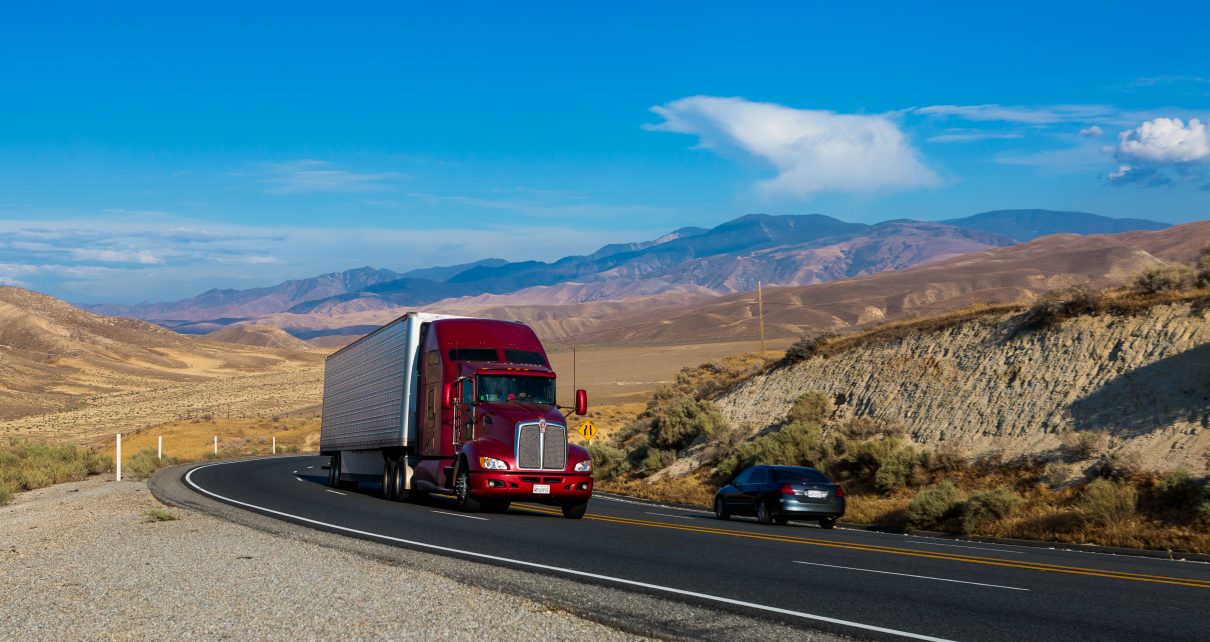
Truck on highway in Bakersfield, CA. (Photo: Clari Massimiliano, Shutterstock)
No Luck For California Trucks: CARB Regulates Sales to Zero
‘Good enough for government work’
By Thomas Buckley, July 29, 2024 9:15 am
So, you want to buy a truck. A big truck, a tractor trailer, a semi, a rig.
You can, just not in California, thanks to the California Air Resources Board (CARB.)
In January, yet another blurch of absurd CARB regulations took effect, regulations that Franz Kafka and/or a Byzantine emperor’s Mesazon (chancellor) would envy.
In typical CARB fashion, it has mandated the use of electric vehicle technology that is not available at scale and will not be for some time. As with its proposed train and, thankfully, recently ended harbor boat pollution regulations, CARB demanded boat and locomotive owners do something that is literally impossible.
And the new truck regulations are even weirder. Even though NOx and particulate truck emissions have decreased 98% over the past decade, CARB is willing to bring the industry in California to a standstill to get that two percent. It’s Zeno’s Government – if want to walk from A to B and move 50% of the distance with every step, you will never get to point B – at work.
“CARB knows what is happening to the industry in California, but doesn’t know what to do,” said Kim Misfin, president of the Affinity Truck Center in Fresno and industry activist (she sits on multiple state and national truck dealer boards.)
And, before we continue, it should be noted that newer trucks in the Central Valley actually really literally seriously emit cleaner air than they take in while driving. That’s how clean the engines being made now are.
But not clean enough for CARB, which is hellbent on electrifying everything in the state, electrifying everything in the state, no matter what. This obsession is driving out clean alternatives like natural gas, hydrogen, and even “renewable diesel,” and “bio diesel (the one made, in part, with the grease taken from restaurants).”
The internal combustion engine, in any form, on any fuel, is anathema to CARB, Misfin said.
“They are all in on electric technology,” Misfin lamented.
Even CARB itself estimates that the switch over to the regs will, in the end, cost more thana 43,000 jobs in California. For example, Affinity sold about 400 trucks last year – this year, none.
This utterly blinkered approach by CARB is actually making the air dirtier and the state far more dependent on a shaky electric grid:
This essential invisibility of electricity is part of its green appeal. When other fuels are used, it is readily apparent to the user – they can see the gas burning in the blue flame on the stove and every time they fill up the tank they vaguely remember from junior high that gas comes from dinosaurs that got smooshed a long time ago and now it’s what your car eats.
In other words, there is a certain noticeable physicality to fossil fuels, while electricity is simply on/off and pay the bill once a month. It is the disconnection caused by this ubiquity that creates the psychological shield of simple ever-presence around electricity, making it nearly immune to “up-stream” (pollution, etc.) concerns and questions about being able to use more – a lot lot lot – more of it.
In other words, CARB is playing a psychological game with people’s livelihoods.
Specifically, right now one cannot buy a new regular diesel truck in the state. Not because of a lack of demand and not because they are dirty (see above,) but because of CARB’s truck sales percentage standards.
As of January 1, a truck dealer had to sell one zero emission vehicle (ZEV) for every 10 vehicles they sold in total. In other words, 10 percent of sales had to be of ZEVs. And, in just a few years, that number goes to one in seven, or 14.5% of all sales.
Problem: No one wants to buy the ZEVs that are available. They do not work as well as regular trucks, they can’t haul equivalent loads, they are far far more expensive, they have limited ranges and, oh yeah, not enough charging stations and if a driver happens to finds a charger the trucks take TEN HOURS to charge.
If you as a dealer somehow managed to sell one ZEV, they could then sell nine diesel trucks.
No such luck.
There are a couple of tricks you can use to get a new diesel truck, one being going to Arizona, buying the truck there, driving it around for 7,500 miles, and then bringing it back into California and registering it as a used truck. That, for whatever reason, is fine with CARB.
As noted before, CARB staff is, um, blinkered, leading to another fascinating aspect of the regulations. Since you can’t get the newer cleaner diesel trucks, you have to keep driving older, dirtier trucks. A semi in 1980 put out 60 times more pollutants than those being sold today and CARB will let you drive your older truck (made less than 18 years ago, it must be noted) for up to 800,000 miles.
As with the proposed locomotive regulations, these new rules actually make the air dirtier because the technology does not exist in any reasonable fashion, at any reasonable scale to implement now.
As to the manufacturers, they are not yet feeling the pinch too too much – they simply sell their trucks elsewhere. But, as in the case of CARB’s proposed rail regulations, if allowed to stand these same regs will spread to other states, either because those states eventually follow CARB standards (about a dozen do) and/or the industry will itself move to producing only CARB-complaint trucks for the entire nation. The state market is so large, the ”knock-on effects” are enormous (see cars.)
There are a couple of new diesel trucks out now that, instead of emitting 2% of what was emitted years ago, only emit .1% of NOx (nitrous oxides – not a greenhouse gas by the way.) Problem with that? Because it’s not ZERO, the manufacturer of the truck still must obtain an emissions “credit” from either an all-electric maker or somewhere else. And, unlike cap and trade, there is no open market for those credits, let alone an inkling as to how much they would cost.
It should also be noted that regulations are based, Misfin said, on potential point- of- ignition emissions, not overall emissions and/or when the trucks are actually driving around. When actually going down the road, the newer trucks meet the standard.
“All of the effort to reduce is strictly to reduce upon start up,” Misfin said.
There is a saying that goes “good enough for government work.” That’s supposed to mean that the work done was fine(ish,) maybe a corner was cut but, whatever, it’s not a big deal.
That’s not a good thing.
But CARB’s version of “good enough for government work” borders on the psychotically obsessive. Somewhere out there there is a molecule of air that is not pristine and that must be fixed! says CARB.
Well, one good thing about that – CARB workers never ever ever have to be worried about being out of a job.
- Benefit Fraud Problems and Solutions - November 7, 2024
- A Little Exit Poll - November 5, 2024
- Tomorrow’s Headlines Today! - November 5, 2024





Gee, CARB demanding that entire industries — trucking, for one —- perform the impossible. Again. Guess we’re screwed then! Have been wondering lately when the Supreme Court Chevron decision is going to kick in, or IF it will, ever? Maybe I didn’t understand it the way I thought I did.
I’m sure readers here heard about the lithium battery fire that shut down I-15, the main highway to Las Vegas, over the weekend while everyone was stuck roasting in their cars in the heat for hours and hours (for all I know they are still there) while Hazmat arrived and did their thing:
“Freeway Connecting California to Las Vegas Still Shut Down as of Saturday”
https://www.vvdailypress.com/story/news/fire/2024/07/27/freeway-connecting-california-to-las-vegas-still-shut-down-as-of-saturday/74570357007/
I won’t even post the video of the e-bike battery that exploded in an elevator because it is too horrifying. Probably a lot of you have seen it already but if you didn’t you can look it up if you’re curious.
So yeah, sure, electric trucks and what-not are the future, right? UH, I don’t THINK SO! And that’s apart from the gang of bureaucrat crazy people at CARB demanding that what’s impossible occur. Kafka, no kidding. The Trial and The Castle are walks in the park compared to what CARB has planned. Happy nightmares!
CARB will soon learn that trucks with diesel engines are different than gasoline engines in cars. Diesel engines can be driven 200,000+ miles and then rebuilt, many times. I suspect that each time a diesel engine is rebuilt. it produces increasing amounts of criteria pollutants so smog will most likely get worse.
How many of us have surmised that real reason CARB exists is to destroy industries and ultimately the state’s economy and the national economy as well? When will Californians say ENOUGH to these unelected partisan stooges and their globalist master’s insane dictates?
The Globe needs to start naming names. Who sits on CARB and what are their backgrounds?
And i would think this all could be challenged in light of SCOTUS’s decision on Chevron
The California Air Resources Board consists of 14 voting members and 2 ex officio nonvoting members who are members of the Legislature, one from the Senate and the other from the Assembly. Of the 14 voting members, 12 are appointed by the Governor with Senate confirmation, and include: 6 who serve on local air districts, 4 experts in fields that shape air quality rules, and 2 public members. The other 2 voting members represent environmental justice communities and are appointed one each by the Senate Rules Committee and the Assembly Speaker. The Chair serves as the only full-time member and is appointed by the Governor from among the voting members.
Board members:
Liane M. Randolph
John Eisenhut
Susan A. Shaheen
John R. Balmes, M.D.
Diane Takvorian
Cliff Rechtschaffen
Dean Florez
Hector De La Torre
Davina Hurt
V. Manuel Perez
Eric Guerra
Nora Vargas
Dr. Tania Pacheco-Werner
Gideon Kracov
Henry Stern
Eduardo Garcia
Hon. Steven S. Cliff
Courtney Smith
Edie Chang
Chanell Fletcher
Annette Hebert
Edna Murphy
Rajinder Sahota
Sydney Vergis, Ph.D.
Ellen M. Peter
(https://ww2.arb.ca.gov/about/leadership)
Perhaps it is time for trucking companies to boycott Kalifornia? Give them what they want (no trucks) and see if they like it.
But why punish the citizens of the state for the failures of UNELECTED BUREAUCRATS whom we cannot remove ???
We tried removing Newsom, but the Democrat blob and their corrupted electronic voting systems prevented the will of the people from being expressed….
The citizens of Kalifornia need a wake up call. A boycott can be reversed in a day. Once the system is destroyed it will take much longer to fix, maybe years of shortages and astronomical prices for the little that makes it into the state by mule team before people wake up a depose the dictatorship of CARB.